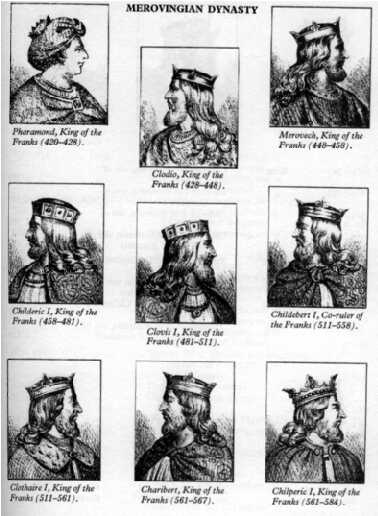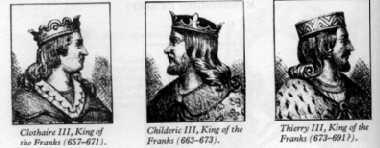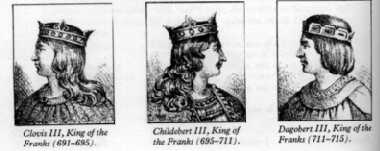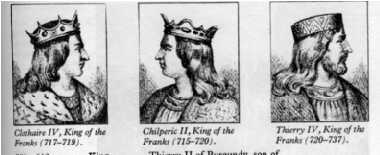The Merovingians
From Kings, Rulers and Statesmen, eds. L F Wise / E W Egan, Sterling (Oak Tree), 1967, 446pp, own.
The Merovingians were the first Frankish (i.e. post-Roman) ruling family dynasty of France (see also France Facts file).
From HBHG p271-4: "the Merovingians themselves, according to their own chroniclers, claimed descent from ancient Troy. But according to certain of the 'Prieure documents' the Merovingian pedigree ... could in fact be traced back to the Old Testament ... the Tribe of Benjamin ... [Deut. 33 God's blessing to Benjaminites, Joshua 18 their land incl. Jerusalem, Judges 20-1 Levite incident and curse] most Benjaminites [went] into exile [result of assault of Levite/wife in their territory "by worshipers of Belial - a variant of the Sumerian mother goddess, known as Ishtar by the Babylonians and Astarte by the Phoenicians" 272, cursed by other tribes ...] ... to Greece, to the central Pelopponesus - to Arcadia, in short, where they supposedly became aligned w/the Arcadian royal line. Toward the advent of the Christian era they are then said to have migrated up the Danube and the Rhine, intermarrying w/certain Teutonic tribes and eventually engendering the Sicambrian Franks - the immediate forebears of the Merovingians (274) ... [assertions of Hebrew origins of Europeans] were neither unique nore new ... vague rumors and nebulous traditions for a long time ... Proust draws upon them in his opus; and more recently the novelist Jean d'Ormesson suggests a Judaic origin for certain noble French families. And in 1965 Roger Peyrefitte, who seems to like scandalizing his countrymen, did so with resounding eclat in a novel affirming all French and most European nobility to be ultimately Judaic"
"Among the 3 clans that comprised the Tribe of Benjamin [hmmm, Benjamin's 5 sons were Bela, Ashbel, Ahiram, Shephupham, Hupham] there was the clan of Ahiram - which might in some obscure way pertain to Hiram, builder of the Temple of Solomon and central figure in Masonic tradition. Hiram's most devoted disciple, moreover, was named Benoni ... the name originally conferred upon the infant Benjamin by his mother, Rachel, before she died" (272). "If there was actually an exodus of Benjaminites from Palestine, one might hope to find some vestigial record of it. In Greek myth one does: in the legend of the son of King Belus, one Danaus, who arrives in Greece w/his daughters, by ship. His daughters are said to have introduced the cult of the mother goddess, which became the established cult of the Arcadians [Spartan ancestors]. According to Robert Graves the Danaus myth records the arrival in the Peloponnesus of 'colonists from Palestine.' Graves states that King Belus is in fact Baal, or Bel - or perhaps Belial from the OT. It is also worthy of note that one of the clans of the Tribe of Benjamin was the clan of Bela. In Arcadia the cult of the mother goddess not only prospered but survived longer than in any other part of Greece. It became associated w/worship of Demeter, then of Diana, or Artemis. Known regionally as Arduina, Artemis became tutelary deity of the Ardennes ... [from which] the Sicambrian Franks first issued into what is now France. The totem of Artemis was the she-bear [hmmm, connected w/Arthur?, see br-doka] - Callisto, whose son was Arcas, the bear-child and patron of Arcadia. And Callisto, transported to the heavens by Artemis, became the constellation Ursa Major, the Great Bear. There might thus be something more than coincidence in the appellation 'Ursus,' applied repeatedly to the Merovingian bloodline" (275-7). The classical Spartans had "absorbed much of the older Arcadian culture ... [and] ascribed a special, magical significance to their hair - which, like the Merovingians, they wore long ... [Macc. 1 and 2 say Jews and Spartans are related]" (277).
So, in addition to the 'traditional Frankish lineage' shown in ahnen-sf (see Pharamond at generation #52) going back via the Sicambrians, Cimmerians and Trojans to Javan son of Noah, we have this similar one going back from Clovis through the Sicambrians, Greeks (Arcadians = proto-Spartans), to the exiled Benjaminites (who would have left shortly after Joshua's c1400 BC conquest of Canaan).
The International Standard Bible Encyclopedia (Crossings [Eerdmans], 1998, SBC) has an interesting article on the Cimmerians under the entry 'Gomer.' They note that this Hebrew name (Assyrian Gimirrai, Greek Kimmerioi) refers to "a nomadic people descended from Japheth and aka Cimmerians. In the [Table of Nations of Gen. 10], Gomer appears among the Indo-European Japhethites, closely related to the Medes, Ionians [Greeks], and certain peoples of Anatolia [Turkey], and the Scythians (Ashkenaz). A similar association is implied in Ezek. 38:6, where Gomer supplies a part of the force of Gog, beside the Persians and other nations. These are the only [2] biblical references to the Cimmerians ... [but] can be supplemented w/historical allusions from Akkadian [Sumerian] sources and references in various classical writers, together w/a certain amount of archeological evidence. The Cimmerians were nomadic herdsmen, apparently unacquainted w/the horse as a mount, and distinguished for their archery (Babylonian texts of the 6C BC list numbers of Cimmerian bows/arrows, after the Cimmerians as a people had ceased to exist). The few personal names preserved suggest that they were of Iranian stock, related to the Scythians, but this is disputed by some scholars. Late in the 2M BC [c1200? BC] they were driven from their homeland N of the Caucasus [mtn range between Black, Caspian Seas] into those mtns and into the Crimea by the Scythians, when [after] their attempted expansion E into China was repulsed. The horse-riding Scythians continued to press the Cimmerians across the Caucasus and into Azerbaijan (Mannai), Armenia, Anatolia, and E Europe. By the end of the 8C BC [c700], the influx of Cimmerians was felt in all the peripheral states N and E of the Fertile Crescent. The power of [Hittite?] Urartu was severely curtailed and the Assyrian king Sargon II was probably killed in a battle that prevented them [Cimmerians] from penetrating S of Lake Van (705 BC). The governors of Esarhaddon of Assyria defeated another attack in the Taurus Mtns [S Turkey] in 679 BC, tho the Cimmerians continued their penetration by serving as mercenaries in the Assyrian army. By 670 the Cimmerians had taken control of central Anatolia, overrunning the Phrygians (Meshech) and their king Midas. Their 1rst assault upon the Lydians was defeated when Gyges gained Assyrian aid c663 BC; but they took Sardis in 652 BC, after Gyges had rebelled against Assyria, and held it until Alyattes drove them out in 626 BC. Until that date they constantly threatened to break through into Assyrian territory, but thereafter the Scythians gradually subjected the Cimmerians, who were absorbed into the local populations and disappeared from history, leaving only their name as the Armenian term for Cappadocia, Gamirk'."
Alphabetical Listing
Descent Charts
Traditional Frankish line shows descent from Noah's son Javan through the Trojans, then Sicambrians. HBHG adds a possible pre-Trojan source from the c1400 BC exile of the Tribe of Benjamin from their land which included Jerusalem, to Arcadia (proto-Spartans), then up the Danube and Rhine to intermarry w/Teutonic tribes and emerge from the Ardennes forest as early Franks. Hmmm.
- MBBKQ shows Pharamond (R1 fl400 d. c427), Chlodian the Hairy (R2 b. c395 r428-47, see DFRE excerpt below), Merovich (R3 b. c415 r447-58), Childeric I (R4), Clovis I (R5)
- 01 Merovee I, origin Sicambrian, Frankish leader in 417, m. Siegse (hmmm, Pharamond? Siegse later m. Clodion VI, origin Salian Frank, King of Cambrai 438-48)
- 02 Merovee II "The Young" King of Franks of Yssel 447-58 b. c415 m. ? (i.e. Merovich R3)
- 03 Childeric I b. c436 r458-81 (R4, HBHG King of Yssel 458-96, grave discovered at Tournai in 1653, see interesting tie-in w/King Arthur in DOKA)
- 04 Clovis I b. c465 r481-511, King of all Franks (R5, HBHG r456-511, baptized by St. Remi 24 Dec 496, m1. Evochilde [pagan] m2. Clothilde [Christian], niece of King of Burgundy)
- at Clovis' death, Frankish kingdom divided among his 4 sons into Austrasia (Rheims, Metz), Neustria (Soissons), Burgundy (Paris?), Lotharia? HBHG shows Thierry son of Evochilde, all others of Clothilde
- 05 Chlodomir, King of Orleans 511-24, k. in battle
- 05 Theodoric (Thierry) I, King of Metz (Austrasia) 511-34 (AEWH) (MBBKQ says ruled Austrasia, based at Rheims)
- 06 Theudebert I, King of Metz (Austrasia) 534-48
- 07 Theudebald, King of Metz (Austrasia) 548-55
- 05 Childebert I, King of Paris 511-58, b. c495
- 05 Chlothar (Lothair, Clotaire) I, King of Soissons 511-58, King of all Franks 558-61, b. c497, 6 wives
- 06 Charibert I b. c522, King of Paris 561-7
- 07 Bertha m. Athelbert I of Kent
- 06 Sigibert (Sigebert) I b. c535, King of Austrasia 561-75, murdered (HBHG m. Brunehaut, dau of Visigoth king)
- 07 Childebert II b. c570, King of Austrasia 575-95, King of Burgundy 593-5
- 08 Theudebert (Theodebert) II, King of Austrasia 595-612
- 08 Theodoric (Thierry) II, King of Burgundy 595-612, King of Austrasia 612-3
- 09 Sigibert (Sigebert) II b. c630, King of Austrasia and Burgundy 613
- 06 Chilperic I b. c539, King of Soissons 561-84, murdered (HBHG m1. Galeswinthe, sister of Brunehaut and dau of Visigoth king m2. Fredegonde [Saxon?])
- w/Fredegonde
- 07 Lothair (Chlothar, Clotaire) II b. c584, King of Neustria (Soissons) 584-628, King of Franks 613-29, 3 wives
- 08 Ymme (dau) m. Eadbald of Kent (MBBKQ p. 212)
- 08 Dagobert I b. c600, King of Austrasia 623-8, King of Franks 629-39 (Austrasia 623-34, Neustria 632-9 MBBKQ), 5 wives, the last strong Merovingian ruler, rcv'd wise advice from Bishop Arnulf and Pepin I (AEWH, see The Carolingians) (HBHG 602-38 K Aust 622-, K France 630-). Mother of Sigibert III was (Austrasian) Ragnetrudis, of Clovis II was Nantechildis (BFG 180)
- 09 Sigibert (Sigisbert) III (MBBKQ says II, r634-56) b. c630, King of Austrasia 632-56, murdered (HBHG 629-56 m. Immachilde)
- 10 Blichilde m. Childeric II 651-74 (her cousin, son of her Uncle Clovis II and Aunt Batilde, HBHG)
- 10 Dagobert II, King of Austrasia 674-8 (MBBKQ: King of Austrasia 656-61, then deposed, then restored 676-9, then murdered, see Grimoald and his son Childebert of Carolingian line and their premature bid to usurp power, leading to pro-Merovingian reaction in 656) (HBHG 651-79, ass. by ?, possibly Pepin [II?] the Fat and/or RCC, m1. 666 Irish Mathilde m2. 671 Giselle de Razes 653-76, god-dau of St. Wilfrid of York, dau of Gislica and Bera II, Count of Razes, Gislica sis of Wamba, King of Visigoths from 672 and dau of Tulca, 1rst Count of Razes, King of Visigoths d642, Bera II son of Bera I, Bera I bro of Annemundus, Bishop of Lyons 653 and son of Sigonius, Prefect of Gaul, source Roman)
- 11 Lothair (Chlothar) IV, King of Austrasia 717-9 (MBBKQ 717-20)
- 11 Sigisbert IV 676-758, "said to have adopted - or inherited - his uncle's titles, duke of Razes and count of Rhedae ... also to have adopted the surname, or nickname, of 'Plant-Ard' meaning 'ardently flowering shoot'" (son of Dagobert II and Giselle de Razes, m. Magdala, see HBHG chart pp262-3 and pages nearby)
- 12 Sigisbert V 695/8-763/8, Count of Razes m. ? (Sigisbert IV, V, Bera III called 'The Hermit Princes' because they sought refuge in the caverns in a hill near Rhedae during the Saracen invasion [later put down by Charles Martel]. The carved tombstone of their common grave is today in the museum at Rennes le Chateau)
- 13 Bera III 715-70 Count of Razes m. Olba (Alda)
- 14 Oliba
- 14 Guillaume, Count of Razes m1. ? m2. ?
- 15 Bera IV 755-813, Count of Razes, founded Abbey of Alet m. Romille
- 16 Rotaude d855 rcv'd Blanchefort [Castle? town?] in her dowry 795 m. Alaric
- 17 Aureol, source of the Blanchefort family ...
- 16 Argila 775-836 Count of Razes m. Reverge
- 17 Bera V 794-860 Count of Razes m. ?
- 18 Hilderic I, Count of Razes d867 m. ?
- 19 Sigisbert VI 'Prince Ursus' d884/5, last Count of Razes of Merovingian descent m. Rotilde, dau of (Carolingian) Charles II the Bald
- ... this line was exiled to Brittany after failure of 881 uprising against Louis II. Chart on pp266-7 picks up here and traces line to Godfrey of Bouillon (see Baldwin)
- 18 Bernard 'Planta-velu' or 'Planta-Pilus' Count of Razes d877, est. Duchy of Aquitaine
- 15 Ode
- 15 Oliba m. Richilde d839
- 16 Oliba, Count of Carcassonne
- 16 Acfred, Count of Razes b870/7/81 d906
- 09 Clovis II b. c634, King of Neustria and Burgundy 639-57 (639-56 MBBKQ, 633-56 m. Batilde HBHG)
- 10 Lothair (Chlothar) III, King of Neustria 657-73, King of Franks 656-60
- 10 Childeric (II) b. c649, King of Austrasia 662-75, King of Franks 673-5 (MBBKQ 661-75, HBHG 651-74 m. Blichilde), murdered
- 11 Chilperic II, King of Neustria 715-21, King of Franks 719-20
- 12 Childeric III, King of Franks 743-51, last Merovingian king, deposed, possibly murdered (HBHG shows him son of Blichilde and Childeric II, pic from tIoC p26)
- 10 Theodoric (Thierry) III, King of Neustria 673-98, King of Franks 678-91 (at his death, the Frankish kingdom was reunited)
- 11 Clovis III b. c682, King of Franks 691-5
- 11 Childebert III b. c683, King of Franks 695-711
- 12 Dagobert III b. c699, King of Franks 711-6 (MBBKQ 711-15)
- 13 Theodoric (Thierry) IV, King of Franks 721-37, deposed, d. 741 (Charles Martel r737-41, see Carolingians)
- 08 Charibert II, King of Aquitaine 629-32
- 06 Gontran (Guntram), King of Burgundy 561-92 (Orleans, Burgundy and Aquitaine MBBKQ)
- 06 2 other kids, acc to HBHG (6 in all)
- 05 ? (dau) m. Ferreolus (from Springer line)
- 05 Clothilde m. Alaric, King of Visigoths (HBHG)
Note: Merovee I and II, Childeric I followed the pagan cult of 'Diana of the Ardennes' (248). Clovis I converted to Christianity.
As the Merovingian dynasty weakened after Dagobert I and holders of the office of maior domus (i.e. Mayor of the Palace in Paris e.g. Pepins) gained influence, "in the peripheral regions of Frisia, Thuringia, Alemannia, Bavaria, Provence, and Aquitaine, local dukes established themselves as princes of autonomous principalities ... The loss of Frisia and [its] northern port of Duurstede and the temporary disruptions in Provence, hobbling its Mediterranean ports of Fos and Marseille, interfered w/both ends of the long-distance commercial relations of the kingdom" (181-2).
Sources:
- Holy Blood, Holy Grail, Michael Baigent, Henry Lincoln, Richard Leigh, 1983 (Note: Recent RBC booklet on DaVinci Code cites a 1993 French court case in which Pierre Plantard (1920-2000) admitted to fabricating and planting in libraries all documents related to the Priory of Sion, including Les Dossiers Secrets d'Henri Lobineau [The Secret Records of Henri Lobineau]).
- www.american-pictures.com
- Worldbook Encyclopedia
- The Mammoth Book of British Kings and Queens, Mike Ashley, 1999 (Carroll & Graf Publishers)
- An Encyclopedia of World History, Ed. Wm. L. Langer, Houghton Mifflin, 1940/48/52/68/72 (Merovingians; 4th? of 104 Genealogy Tables, p. 162)
- tIoC = The Importance of Charlemagne, Timothy Levi Biel, Lucent, 1997 (FHL)
- BFG = Before France and Germany, Patrick J Geary, Oxford, 1988, own









